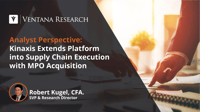We’ve experienced an unusual, decades-long monetary policy in the developed world that emphasized interest rate repression as well as supply chain practices designed for lowest cost. This has produced a generation of chief financial officers likely unprepared to address the impact of fundamental changes now shaping a new, technology-driven approach to working capital optimization. Today’s CFOs must assess their working capital management processes and the systems that support them to balance...
Read More
Topics:
Office of Finance,
Enterprise Resource Planning,
continuous supply chain,
digital finance,
Sustainability Management,
Purchasing/Sourcing/Payments
Early last December, just before ChatGPT became the new, bright, shiny object, The Economist magazine ran a story proclaiming that we had finally arrived at the age of boring artificial intelligence (AI). From my perspective, it’s unfortunate that didn’t last and that AI has been relegated back to the buzzword league. AI will be an increasingly important feature of business software through the end of this decade. Ventana Research asserts that by 2026, almost all vendors of software designed...
Read More
Topics:
Office of Finance,
Business Intelligence,
Business Planning,
Enterprise Resource Planning,
ERP and Continuous Accounting,
natural language processing,
continuous supply chain,
digital finance,
AI & Machine Learning,
Purchasing/Sourcing/Payments,
Consolidate/Close/Report
Digitally transforming core business processes became essential as organizations locked down in early 2020 because of the pandemic and the need to operate remotely presented a set of new challenges that were best addressed by software. Especially in the areas of sourcing, purchasing and payments, software has the ability to streamline processes, shorten process cycles, reduce unnecessary costs, provide greater visibility into cash flows, increase control and improve results. Digitizing...
Read More
Topics:
ERP,
Office of Finance,
continuous supply chain,
digital finance,
Purchasing/Sourcing/Payments
Maersk is closing its TradeLens joint venture with IBM that began in 2018. It was intended to enable port operators, customs authorities, freight forwarders and importers to track containers and their contents. The system was designed to substantially reduce the inefficiencies and delays created by paper-based systems used for customs, trade finance, tariffs and taxes as well as supply chain and logistics management. The initiative was designed to cut supply chain latency by reducing the time...
Read More
Topics:
Operations & Supply Chain,
blockchain,
continuous supply chain,
operational data platforms
The cloud has come to dominate many business software categories, but until recently, enterprise resource planning for manufacturing and product-focused organizations has been a notable laggard. Cloud-based systems can be less costly to operate, perform better, be more secure and shift maintenance and update chores from the IT department to the vendor, freeing IT teams to concentrate on more strategic needs.
Read More
Topics:
Office of Finance,
Operations & Supply Chain,
Enterprise Resource Planning,
ERP and Continuous Accounting,
continuous supply chain,
digital finance
Ventana Research recently announced its 2023 research agenda for Operations and Supply Chain, continuing the guidance we’ve offered for nearly two decades to help organizations across industries derive optimal value and improved outcomes from business technology.
Read More
Topics:
Continuous Planning,
Product Information Management,
Operations & Supply Chain,
Enterprise Resource Planning,
continuous supply chain,
supplier relationship management,
Property Technology
Ventana Research uses the term “data pantry” to describe a method of data storage (and the technology and process blueprint for its construction) created for a specific set of users and use cases in business-focused software. It’s a pantry because all the data one needs is readily available and easily accessible, with labels that are immediately recognized and understood by the users of the application. In tech speak, this means the semantic layer is optimized for the intended audience. It is...
Read More
Topics:
Continuous Planning,
Business Intelligence,
Data Management,
Business Planning,
Data,
Financial Performance Management,
Enterprise Resource Planning,
continuous supply chain,
data operations,
digital finance,
AI & Machine Learning,
profitability management,
Analytics & Data,
Streaming Data & Events
Kinaxis recently announced it has acquired a Netherlands-based company, MPO, a cloud-based software offering that orchestrates multiparty supply chain execution. The combination is designed to enable Kinaxis to extend its concurrent planning platform to handle core elements of supply chain execution. Kinaxis acquired all the shares of MPO for approximately US$45 million, with some of the final consideration dependent on performance. MPO will continue to operate as a standalone business, but...
Read More
Topics:
Business Intelligence,
Business Planning,
Operations & Supply Chain,
Enterprise Resource Planning,
continuous supply chain,
AI & Machine Learning
Anaplan offers a cloud-based business planning platform that incorporates a modeling and calculation engine. The tool makes it relatively easy to add or expand the scope of plans that can be connected and monitored on a single platform. This Integrated Business Planning (IBP) approach enables organizations to use the software for financial planning or budgeting, sales, supply chain, workforce, marketing and IT planning. These are the types of plans in which companies often need to create models...
Read More
Topics:
Continuous Planning,
Business Intelligence,
Business Planning,
Financial Performance Management,
continuous supply chain,
digital finance,
AI & Machine Learning,
profitability management
Kinaxis is a sales and operation planning software company headquartered in Ottawa, Canada. Its RapidResponse is an S&OP platform for concurrent planning, designed to integrate an organization’s supply chain planning silos, accelerate planning cycles and optimize supply chain execution to match customer demand.
Read More
Topics:
Continuous Planning,
Business Planning,
Enterprise Resource Planning,
continuous supply chain



















